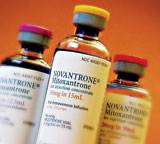A
Journey with Multiple Sclerosis
By Sharon Bosch
I’m embarking on the arduous
undertaking of describing the last 13 years of my life so that others might
gain insight, understanding, and hope from my journey.
I married my best friend and
husband in 1998 and became the proud mom to our beautiful son in 2003. I’m a
stay at home mom, but not by choice – by circumstance. On June 4, 1999, my
physician diagnosed me with multiple sclerosis
(MS). MS affects people in varying degrees. Some can continue to work, but
for others, the ravages of the disease make working and a career impossible.
In the past, prior to
diagnosis, I never just sat around idly, burning up daylight and wasting time.
I truly enjoyed working. But – after diagnosis, I simply couldn’t work. I
became a new Sharon – an ill Sharon. I could have balanced family life and a
thriving career quite well; at least I think
I could have. MS made it impossible for me to even try.
What Is MS?
The term, multiple sclerosis,
means many scars or lesions. MS is a
demyelinating, autoimmune disease that affects the central nervous system
(CNS). I’ll give you a brief overview of the disease without boring you with
all the medical jargon. Although researchers aren’t clear on the exact cause, the
most common theory is that a gene defect or a virus triggers the physiological
process that develops into MS. The disease damages the myelin sheath
(demyelization) that surrounds and protects nerve cells. The propagation of
nerve signals slows down and even stops in some cases.
The nerve damage, or
demyelization, is caused by inflammation. Much like your body’s immune system
fends off a cold, by attacking the invading virus, the body’s immune cells
attack the nervous system, causing the inflammation. The inflammation can crop
up anywhere along the CNS (e.g. brain, spinal cord, optic nerve).
The Nature of the Beast
As of 2012, approximately 2.1
million people have MS worldwide, making it the most commonly diagnosed
demyelinating disease among young adults. Of those, 400,000 of them are
Americans. Those numbers tell an astounding story: fully 1/5 of those with MS
are US citizens. The average age of diagnosis is between 20 and 40 years of
age. Although men can certainly develop MS, most of the MS population is
female.
Episodes of the disease can
last a day to several days or more and can occur at different locations of the
body each time and with varying severity. The disease goes into remission for
periods of time when patients do not experience symptoms, but can pop up again
without warning.
Common Symptoms of MS
·
Numbness,
tingling, or burning sensations in the hands, feet, or legs. Some people
experience these symptoms all over their bodies.
·
Complete
loss of sight in one or both eyes, loss of peripheral vision, loss of visual
acuity (occurs when the inflammation occurs on and around the optic nerve)
·
Loss of
balance, unsteady gait, spasticity
·
Heat
intolerance – the core body temperature of those with MS rises quicker than in
healthy people, due to issues with the thalamus gland (an organ involved in
temperature regulation).
·
L’hermitte
Syndrome - feeling of electrical shock that runs down the arms and legs when
bending the neck to the chin.
·
General
loss of coordination
·
Slurred
speech
·
Bladder
control issues
·
Bowel
control issues
·
Cognitive
difficulties
·
MS Hug –
a tightening around the mid-section, which can mimic the feeling of a heart
attack, or feeling as if your clothing is too tight, when it actually is not.
Those represent the most
common, basic symptoms of MS, but there are actually a lot more of them – too
many to list as I need to get on with my story. At least you get the gist; MS
is no picnic.
Simple Girl, Proud Woman, Young Wife
I grew up in Gravesend
Brooklyn – born, raised, and proud. If you were to hear me speak, I’m sure
you’d detect an unmistakable accent. We were a middle class family. I had an
Italian mom and a dad of Polish, Irish, and German heritage. Everyone knew
everyone else in our tight-knit community. I had the typical childhood
illnesses (i.e. strep throat, chicken pox). It seems like I fell ill more often
than most kids in my neighborhood, but it is what it is – people just dealt
with it and moved on.
I did the normal teenage
things; perhaps a little more than some, but overall, I wasn’t a bad kid. We
went out, had fun, loved clubbing, etc. I met my husband at a club on Long Island.
I was 22 and he was 25. We lived together about six years before marrying. We
both worked crazy hours to save money and put our wedding together, while still
maintaining a household and paying the bills.
About six months before we
married, I noticed my left hand went numb while taking a fairly hot shower. I
thought it a bit odd, but due to the stress of planning the wedding and all, I
chalked it up to nervous bride syndrome. The numbness and tingling only
happened in my left hand and went away with time.
We married and resumed our
lives. I walked to and from work every day, six days a week, which kept me in
good shape as did all the running around in the office.
Trembling and Stumbling
Suddenly, I began having
issues with walking. I walked like a drunken woman – swaying side to side,
tripping over my own two feet. I even had trouble remembering how to perform my
work duties; duties I had done day in and day out for years. The numbness
returned too. This time, it never went away. I felt exhausted constantly.
Regardless of how much sleep I got, it was never enough.
I visited my family doctor
and I explained my symptoms to him. He suggested that I see a neurological
specialist. A week later, I met with my neurologist. After the typical battery
of tests, he ordered a blood panel to rule out Lyme disease, Lupus, and other
diseases detectable in the blood.
It all came back clean.
Next, he ordered an MRI with
contrast. In this procedure, a huge machine takes images of the brain. The
contrasting agent illuminates any brain lesions present. My brain lit up like a
Christmas tree. Not good!
I then had to undergo a
spinal tap, also called a lumbar puncture (LP), to check for protein in the
cerebrospinal fluid. Ding, ding! Of course, my fluid had protein present,
indicating a blood brain barrier breach and multiple sclerosis. I also went in
for a Visual Evoke Potential test to see if my optic nerve had suffered any
damage. Ironically, I passed that one.
MS Hits Hard
Doctors officially diagnosed
me on a warm Friday afternoon in June of 1999. That Monday, June 7th,
I entered the hospital as an inpatient for my first steroid treatment. The
steroid treatments help MS patients recover from the episodic attacks of the
disease. My medical team gave me 1,000 cc (milligrams) of intravenous (IV)
steroids once a day for three days. They instructed me to taper off my dosage
by mouth over a three-week period and slowly recuperate at home. Six weeks
after my diagnosis, I went back to work, thinking I could do all the things I
did before my illness.
Big Mistake!
Six weeks after returning to
work, another relapse hit me. Hard. I landed in the hospital with optic
neuritis (inflammation of the optic nerve) and received 14,000 cc of IV
steroids. Doctors then told me I have an aggressive form of MS and that I could
no longer work. I quit with a heavy heart and much trepidation.
At the time of my diagnosis,
MS patients had only three medications available to abate the progression of
the disease: Avonex®, Betaseron®, Copaxon®,
and symptomatic medications.
I started my first interferon
medication, Betaseron®. It’s a daily subcutaneous (sub q) injection
with a small needle. Side effects include flu-like symptoms, which hit me like
a freight train. The purpose of this medication is to slow the progression of
the disease. I was still in the throes of relapse and heavy symptoms while on
the medication. My body built up antibodies to the drug, so doctors took me off
of it within the first year.
A Warrior Emerges
Next stop, Copaxone®
-- not an interferon, so comes with few side effects, but still a protein-based
drug. I did those injections faithfully for about a year or so. Then I became
pregnant with my son and stopped immediately.
After giving birth – one of
the most joyous occasions of my life – I had a relapse. This is par for the
course after having a baby. I did at-home IV steroid treatment and didn’t
return to using Copaxone®. My son needed his new mom and I did OK.
As is my nature, I tempted
fate one too many times. I fell, stumbled, tripped, dropped things, and lost
some vision in my left eye (again). If you remember, I first felt the numbing
in my left hand well before getting a diagnosis. Most MS patients have one side
that’s worse than the other. The left side is my bad side.
When I visited my
neurologist, he chastised me for not taking my medication treatments over the
past four years. I had more active lesions than ever and went downhill fast. My
doctor started me on Rebif®, another, newer, interferon that’s
stronger than Betaseron®. Interferons give me flu-like symptoms,
meaning I felt like crap – again.
Three years after that, I
moved on from my neurologist to an MS specialist and he wants to put me on a
newer, highly promising medication. Patients take the medication, called
Tysabri®, via an IV infusion once per month.
But there’s a catch. Isn’t there always a
catch?
Not everyone is a candidate. Those
who carry the JVC-6 virus cannot take the drug. I’m waiting to see whether I
carry this usually harmless virus. Sadly, over 200 people have died using
Tysabri®. These people carried the virus and developed an
untreatable brain disease called Progressive
Multifocal Leukoencephalopathy (PML), due to viral interaction with the
drug.
So, I wait. I wait to find
out if I’m a candidate. If I am, I’ll switch very soon. It’s frightening, and I
can’t say I’m all that enthused, but MS takes many things out of a person’s
control. I’m no different. I’ve got to do what I’ve got to do.
That said, many things are in your control as an MS patient. MS
cannot take away your identity, your values – your core. You are strong,
intelligent, a mom, a dad; you’re anything you want to be. You may need to do
things differently, but you can still do them and live life on your terms, your way, to the best of your ability. I say, “Fight the good
fight. The warrior’s battle. You don’t have time for anyone or anything that
gets in the way of LIVING!”
Sharon Bosch
MS Warrior and Survivor



























